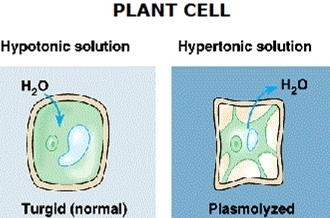Why does plant cell shrink when kept in hypertonic solution?
When a plant cell is placed in a hypertonic solution, water moves out, first from the cytoplasm and then from the vacuole. Cell membrane shrinks away from the cell wall. This is known as plasmolysis.
A hypertonic solution has more dissolved solute than the cytoplasm of the cell. Hence, exosmosis occurs and water moves from a low solute concentration (inside the cell) to high solute concentration (outside the cell). This leads to plasmolysis.
Plasmolysis can be reversed if the cell is placed in a hypotonic solution.
EXPLANATION: If a plant cell is placed in a hypertonic solution, the plant cell loses water and hence turgor pressure by plasmolysis: pressure decreases to the point where the protoplasm of the cell peels away from the cell wall, leaving gaps between the cell wall and the membrane and making the plant cell shrink and crumple. After plasmolysis the gap between the cell wall and the cell membrane in a plant cell is filled with hypertonic solution. This is because as the solution surrounding the cell is hypertonic, exosmosis takes place and the space between the cell wall and cytoplasm is filled with solutes, as most of the water drains away and hence the concentration inside the cell becomes more hypertonic. The liquid content of the cell leaks out due to exosmosis. The cell collapses, and the cell membrane pulls away from the cell wall (in plants).